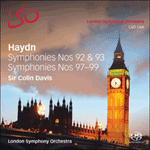
Welcome to Hyperion Records, a British classical label devoted to presenting high-quality recordings of music of all styles and from all periods from the twelfth century to the twenty-first.
Hyperion offers both CDs, and downloads in a number of formats. The site is also available in several languages.
Please use the dropdown buttons to set your preferred options, or use the checkbox to accept the defaults.

| London Symphony Orchestra, Sir Colin Davis (conductor)» More |
It was the musicologist and composer Donald Tovey who first suggested that the Adagio was Haydn’s requiem for his friend Mozart, who had died the previous December. Certainly the echoes of the ‘Jupiter’ Symphony’s Andante are hard to miss in this sublime movement, in full sonata form. In the recapitulation, the hymn-like main theme (which Haydn seems to have modelled on ‘God save the King’) is poignantly intensified, first with a counterpoint for solo cello, then in woodwind imitation, and finally in an aching new chromatic harmonization. Even the minuet, with its suavely melodious trio, is less flamboyant than those in Nos 93, 94 and 96. There is a delicious moment in the second part when the music dips insouciantly from F major to A flat for a demure flute solo. Haydn the humorist is immediately to the fore in the irrepressible 6/8 finale. The cheeky second theme belongs to the world of Rossini’s Figaro (the Italian was a great admirer of Haydn’s symphonies); and the comedy continues in the development, with its violin solos for Salomon in wildly contrasting keys, and the huge coda. Near the end, after what sounds like a pause for a cadenza, Haydn slows down the main theme with mock solemnity, and then decorates it with a ‘cembalo [i.e. fortepiano] solo’ for himself—an effect that doubtless brought the house down in 1792.
from notes by Richard Wigmore © 2009
Ce fut le musicologue et compositeur Donald Tovey qui, le premier, suggéra que l’Adagio était le requiem écrit par Haydn pour son ami Mozart, mort en décembre. Et de fait, difficile de rater les échos de l’Andante de la Symphonie «Jupiter» dans ce sublime mouvement, une complète forme sonate. Dans la réexposition, le thème principal hymnique (apparemment modelé sur «God save the King») connaît une poignante intensification, d’abord avec une contrepoint pour violoncelle solo, puis dans une imitation aux bois, enfin dans une contrariante et nouvelle harmonisation chromatique. Même le menuet, avec son trio doucereusement mélodieux, est moins flamboyant que ses pendants des nos 93, 94 et 96. Un délicieux moment survient dans la seconde partie, quand la musique plonge, insoucieuse, de fa majeur à la bémol pour un sage solo de flûte. Haydn l’humoriste se manifeste d’emblée dans l’irrépressible finale à 6/8. Le second thème effronté appartient à l’univers du Figaro de Rossini (l’Italien était un grand admirateur des symphonies de Haydn); et la comédie se prolonge dans le développement, avec des solos de violon destinés à Salomon, dans des tonalités furieusement contrastives, et dans l’énorme coda. Vers la fin, après ce qui s’apparente à une pause pour une cadenza, Haydn ralentit le thème principal avec une pseudo-solennité pour l’orner ensuite d’un «solo de cembalo [i.e. fortepiano]»—un effet qu’il s’était réservé et qui, à coup sûr, cassa la baraque en 1792.
extrait des notes rédigées par Richard Wigmore © 2009
Français: Hypérion
Der Musikwissenschaftler und Komponist Donald Tovey war der Erste, der den Vorschlag machte, dass das Adagio Haydns Requiem für seinen Freund Mozart war, der im Dezember zuvor gestorben war. In diesem sublimen Satz in voller Sonatenform sind die Anklänge an das Andante der „Jupiter“-Symphonie kaum zu überhören. In der Reprise wird das hymenhafte Hauptthema (in dem sich Haydn scheinbar „God save the King“ zum Vorbild genommen hatte) schmerzlich intensiviert, zunächst mit einem Kontrapunkt des Solocellos dann in Imitation der Holzbläser und schließlich in einer schmerzlichen neuen chromatischen Harmonisierung. Selbst das Menuett mit seinem weltmännisch-melodiösen Trio ist weniger extravagant als die in Nr. 93, 94 und 96. Im zweiten Abschnitt gibt es einen deliziösen Moment, wenn die Musik für ein züchtiges Flötensolo unbekümmert von F-Dur nach As-Dur abgleitet. Im unwiderstehlichen 6/8-Finale tritt Haydn, der Humoriker, unmittelbar in den Vordergrund. Das schelmische zweite Thema gehört zur Welt von Rossinis Figaro (der Italienier war ein großer Bewunderer von Haydns Symphonien), und die Komödie geht in der Durchführung mit ihren Violinsoli für Salomon in wild kontrastierenden Tonarten und der enormen Coda weiter. Gegen Ende, nach einer Fermate wie für eine Kadenz verlangsamt Haydn das Thema mit Pseudofeierlichkeit und verziert es mit einem „Cembalo [d.h. Fortepiano] solo“ für sich selbst—ein Effekt, der 1792 bestimmt donnernden Applaus verursachte.
aus dem Begleittext von Richard Wigmore © 2009
Deutsch: Renate Wendel
 Haydn: Symphonies Nos 92-3 & 97-9 Haydn: Symphonies Nos 92-3 & 97-9Sir Colin Davis was long recognized as a pre-eminent Haydn interpreter. During his Indian summer with the orchestra he recorded both 'The Creation' and 'The Seasons' for LSO Live. The symphonies presented here were recorded in 2011 during this sam ...» More |

